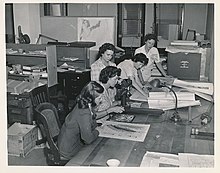Military geology

| Part of a series on |
| Geology |
|---|
 |
Military geology is the application of geological theory to warfare and the peacetime practices of the military. The formal practice of military geology began during the Napoleonic Wars; however, geotechnical knowledge has been applied since the earliest days of siege warfare.[1][2][3] In modern warfare military geologists are used for terrain analysis, engineering, and the identification of resources. Military geologists have included both specially trained military personnel and civilians incorporated into the military. The peacetime application of military geology includes the building of infrastructure, typically during local emergencies or foreign peacekeeping deployments.[1]
Warfare can change the physical geology. Examples of this include artillery shattering the bedrock on the Western Front during World War I[4] and the detonation of nuclear weapons creating new rock types.[5] Military research has also led to many important geological discoveries.
Terrain analysis
[edit]


Geologists have been employed since the Napoleonic Wars to provide an analysis of terrain which was expected to become a war theater, both in case of an upcoming battle and to assess the difficulty of logistical supply.[3][7][8] Academically, it has been found that battles are likely to occur on rocks of Permian, Triassic, or Upper Carboniferous age, possibly due to their typical relief and drainage.[9] More practically, geology has been used in identifying the best Allied invasion sites during World War II, including those in North Africa, Italy, and France.[9] This included studying the properties of the sand of Normandy beaches, the tolerance of the soil in the hinterland to bombardment, the sediment of the English Channel sea floor,[10] and the occurrence of landslides in Sicily.[9] Likewise, German geologists created maps of southern England for Operation Sea Lion, identifying quarry locations and the suitability of rock types to excavate trenchers, etc.[11]
In the Demilitarized Zone between North and South Korea, very rugged terrain is due to the structure of metamorphic rocks, while the best flat land is underlain by granite. During the Korean War, these flat areas were used as military staging grounds by the North Koreans. It has been suggested that an understanding of the fracture and foliation patterns of the metamorphic rocks could help a field commander.[12]
This field partially overlaps with military geography. For this reason the British Army employed geographers in this role until the end of 1941, when it joined international common practice and started using geologists.[9]
Geotechnical engineering
[edit]Geologists have been involved in the construction of forts, tunnels, and bunkers both during military conflicts and in peacetime.[1][13] This included digging tunnels in northeastern Italy and Austria during the so-called mine war in World War I. The rocks of the Dolomites are different from those in other theaters and specialists were required in order to design the tunnels. Explosives were then put in the tunnels and detonated, to cause rock falls and undercut enemy troops.[13][14]
Geology is also used in determining the likely resistance of enemy defenses to shelling and bombing.[15] In World War II, this task was performed by the Allies as they advanced across German-occupied Europe, assessing the likely effect of bombing bridges and shelling defenses in light of the local geology.[9] During peacetime, similar methods have been used, such as the decision to locate the American Strategic Petroleum Reserve in the salt domes of the Gulf Coast.[16]
Resource acquisition
[edit]Geologists are used to determine both the location and accessibility of strategic and tactical resources during war.[1][17] In the case of the D Day landings and the 2003 invasion of Iraq, ground water and aggregate were the two most important geological resources to identify for the campaign. The aggregate was required both for roading metal and for the construction of airfields.[17][18] Since 1966, the German Army has also been using geologists to mitigate and predict the environmental effects of civilian resource extraction.[19]
Forensics
[edit]Graphs are unavailable due to technical issues. Updates on reimplementing the Graph extension, which will be known as the Chart extension, can be found on Phabricator and on MediaWiki.org. |
Geology has been used in many military intelligence investigations. During World War II, the American Military Geology Unit discovered the origin of balloon bombs which had been dispatched towards North America from Japan. They accomplished this by determining from which beach the sand in the balloon's ballast originated.[20] Knowledge of rock types and seismic propagation also allows geologists to distinguish between natural and nuclear test initiated earthquakes.[3]
Effect of warfare on rocks
[edit]Military activity affects the physical geology. This was first noted through the intensive shelling on the Western Front during World War I, which caused the shattering of the bedrock and changed the rocks' permeability.[4] New minerals, rocks, and land-forms are also a byproduct of nuclear testing.[5]
Discoveries by military
[edit]Military research has led to many geological discoveries; however, secrecy has often delayed some of the possible progress.[21] The Austrian Army of World War I included geologists called Kriegsgeologen who were allowed to carry out non-military scientific investigation during the war.[13][14] Discoveries have included new natural resource deposits[22] and the mapping of magnetic stripes on the ocean floor, leading to the idea of plate tectonics.[21]
See also
[edit]- 24th Waffen Mountain Division of the SS Karstjäger
- Australian Mining Corps
- Military Geology Unit
- Tunnelling companies of the Royal Engineers
- U.S. Army Corps of Engineers
References
[edit]- ^ a b c d e James R. Underwood, Jr. Peter L. Guth (1998). "Military Geology in War and Peace". Geological Society of America. 13. ISSN 0080-2018.
- ^ Erdmann, C. E. (1943). "Application of geology to the principles of war". Geological Society of America Bulletin. 54 (8): 1169–1194. Bibcode:1943GSAB...54.1169E. doi:10.1130/GSAB-54-1169. ISSN 0016-7606.
- ^ a b c Kiersch, George A.; Underwood, James R. (1998). "Geology and military operations, 1800–1960: An overview". Military Geology in War and Peace. Reviews in Engineering Geology. Vol. 13. pp. 5–28. doi:10.1130/REG13-p5. ISBN 0-8137-4113-0. ISSN 0080-2018.
- ^ a b Bressan, David (2014). "Battlefield Earth – the Geological Legacy of War". blogs.scientificamerican.com.
- ^ a b Eby, Nelson; Hermes, Robert; Charnley, Norman; Smoliga, John A. (2010). "Trinitite—the atomic rock". Geology Today. 26 (5): 180–185. Bibcode:2010GeolT..26..180E. doi:10.1111/j.1365-2451.2010.00767.x. ISSN 1365-2451.
- ^ "BRANCASTER BEACH - WWII Heritage". www.worldwar2heritage.com. Retrieved 2019-04-26.
- ^ Rose, Edward P. F.; Nathanail, C. Paul (2000). Geology and Warfare: Examples of the Influence of Terrain and Geologists on Military Operations. Geological Society of London. ISBN 9781862390652.
- ^ Kiersch, George A. (1998). "Engineering geosciences and military operations". Engineering Geology. 49 (2): 123–176. Bibcode:1998EngGe..49..123K. doi:10.1016/S0013-7952(97)00080-X. ISSN 0013-7952.
- ^ a b c d e Andrews, Robin. "Meet The Covert Geologists That Helped The Allies Win The Second World War". Forbes. Retrieved 2019-04-23.
- ^ Rose, Edward P. F.; Pareyn, Claude (1998). British applications of military geology for 'Operation Overlord' and the battle in Normandy, France, 1944. Reviews in Engineering Geology. Vol. 13. pp. 55–66. doi:10.1130/REG13-p55. ISBN 0-8137-4113-0. ISSN 0080-2018.
- ^ Rose, Edward P. F.; Ehlen, Judy; Lawrence, Ursula L. (2019). "Military use of geologists and geology: a historical overview and introduction". Geological Society, London, Special Publications. 473 (1): 1–29. Bibcode:2019GSLSP.473....1R. doi:10.1144/SP473.15. ISSN 0305-8719. S2CID 135118323.
- ^ Cameron, C. P. (1998). "Dearly bought ridges, steep access valleys, and staging grounds: The military geology of the eastern DMZ, central Korean Peninsula". Military Geology in War and Peace. Reviews in Engineering Geology. Vol. 13. pp. 83–98. doi:10.1130/REG13-p83. ISBN 0-8137-4113-0. ISSN 0080-2018.
- ^ a b c Bressan, David. "War Geology". Retrieved 2019-04-22.
- ^ a b Macleod, Roy (2009). "' Kriegsgeologen and practical men': military geology and modern memory, 1914–18". The British Journal for the History of Science. 28 (4): 427. doi:10.1017/S0007087400033483. ISSN 0007-0874. S2CID 131282816.
- ^ Eastler, Thomas E.; Percious, Donald J.; Fisher, Paul R. (1998). "Role of geology in assessing vulnerability of underground fortifications to conventional weapons attack". Military Geology in War and Peace. Reviews in Engineering Geology. Vol. 13. pp. 173–188. doi:10.1130/REG13-p173. ISBN 0-8137-4113-0. ISSN 0080-2018.
- ^ Neal, James T. (1998). "Swords into plowshares: Military geology and national security projects" (PDF). Military Geology in War and Peace. Reviews in Engineering Geology. Vol. 13. pp. 111–116. doi:10.1130/REG13-p111. ISBN 0-8137-4113-0. ISSN 0080-2018.
- ^ a b Knowles, Robert B.; Wedge, William K. (1998). "Military geology and the Gulf War". Military Geology in War and Peace. Reviews in Engineering Geology. Vol. 13. pp. 117–124. doi:10.1130/REG13-p117. ISBN 0-8137-4113-0. ISSN 0080-2018. S2CID 5341529.
- ^ Rose, Edward P. F.; Pareyn, Claude (1998). British applications of military geology for 'Operation Overlord' and the battle in Normandy, France, 1944. Reviews in Engineering Geology. Vol. 13. pp. 55–66. doi:10.1130/REG13-p55. ISBN 0-8137-4113-0. ISSN 0080-2018.
- ^ Rose, Edward P. F.; Nathanail, C. Paul (2000). Geology and Warfare: Examples of the Influence of Terrain and Geologists on Military Operations. Geological Society of London. ISBN 9781862390652.
- ^ "Japanese Vengeance Balloon Bombs of World War II - J. David Rogers". web.mst.edu. Retrieved 2019-04-25.
- ^ a b Weisberger, Mindy; December 13, Senior Writer; ET, 2018 08:15am (13 December 2018). "US Navy's Secrecy Likely Stalled Ocean Science Progress for Decades". Live Science. Retrieved 2019-04-23.
{{cite web}}: CS1 maint: numeric names: authors list (link) - ^ Neal, James T. (1998). "Swords into plowshares: Military geology and national security projects" (PDF). Military Geology in War and Peace. Reviews in Engineering Geology. Vol. 13. pp. 111–116. doi:10.1130/REG13-p111. ISBN 0-8137-4113-0. ISSN 0080-2018.
